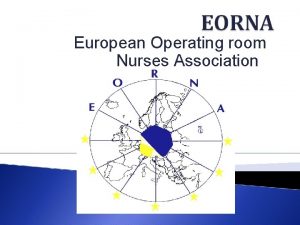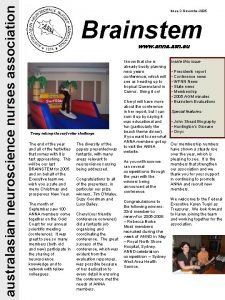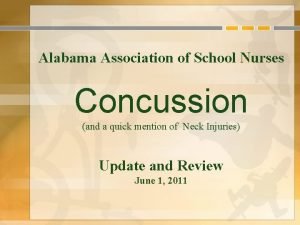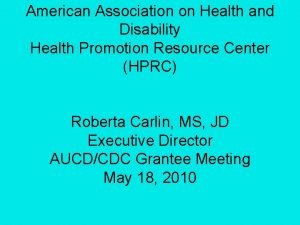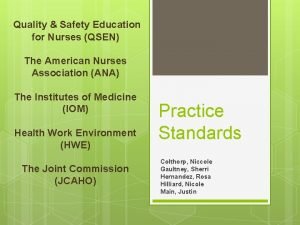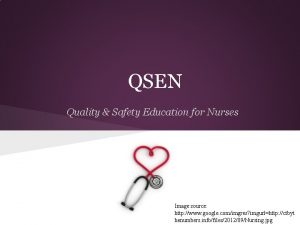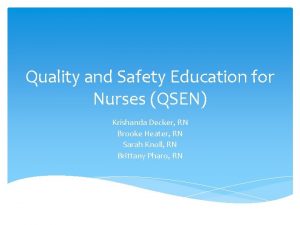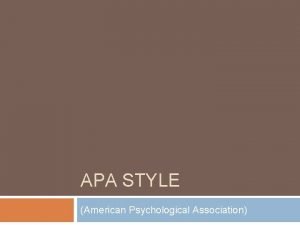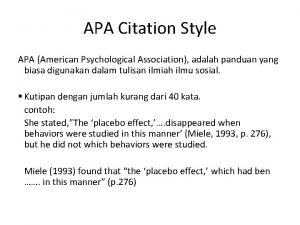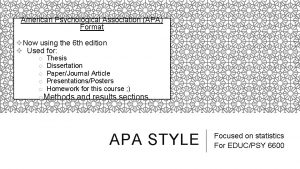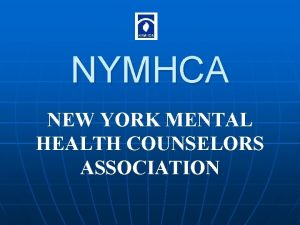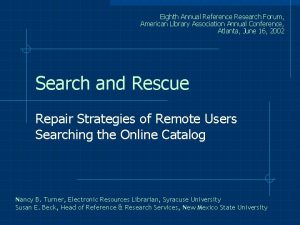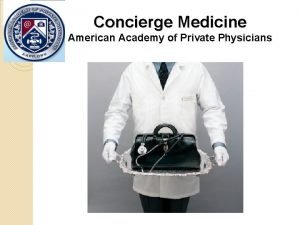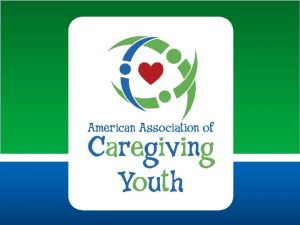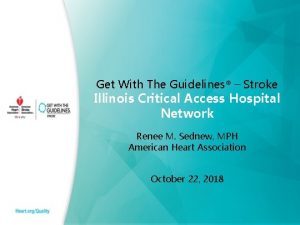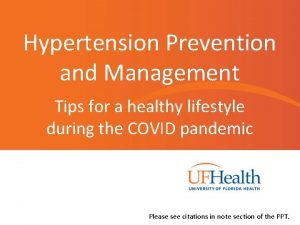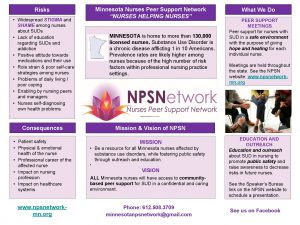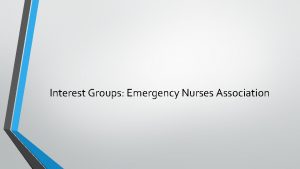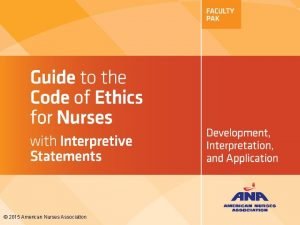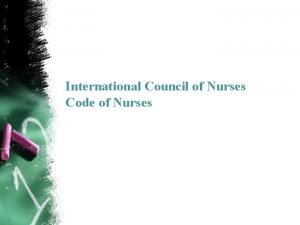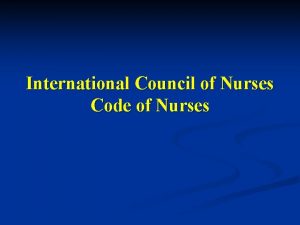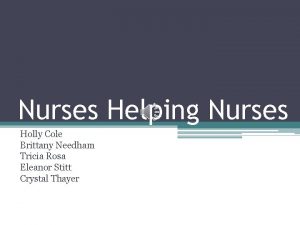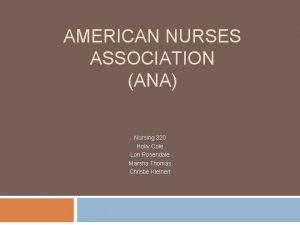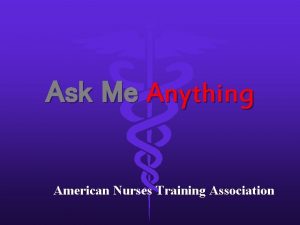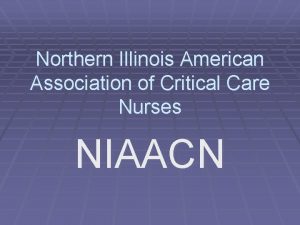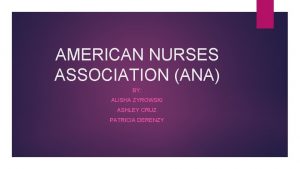2015 American Nurses Association PURPOSE AND EVOLUTION OF





















































- Slides: 53

© 2015 American Nurses Association

PURPOSE AND EVOLUTION OF THE CODE AND PROVISIONS 1 -3, NURSES AND PATIENTS © 2015 American Nurses Association Slide Deck 1

Provisions 1 -3, Nurses and Patients What do we mean by nurses and patients? Provisions 1 -3 address direct patient care and describe the most fundamental values and commitments of the nurse. 3

Scope of Nursing Ethics Unless separately referenced, all content comes from ANA’s Code of Ethics for Nurses with Interpretive Statements, 2015 (“the Code”) OR Fowler, M. D. M. (2015). Guide to the code of ethics for nurses: Development, application, and interpretation (2 nd Ed. ). Silver Spring, MD: American Nurses Association. *All images are public domain under the Creative Commons license and were retrieved from http: //pixabay. com/en/. The question mark icon throughout indicates a discussion point or question to engage in dialogue. 4

What Is Ethics? § A specialized area of philosophy dating back to ancient Greece and earlier § § Concepts of Hippocrates still inform today’s ethical issues. A systematic study of what is right and good measured against principles, virtues and core values of a profession. 5

Scope of Nursing Ethics Deals with: § Character (what sort of person one ought to be) § Conduct (how one should act) Deals with duties and obligations of nurses to: § Patients § Other health professionals § The profession § The wider public § Global humanity 6

Why Ethics in Nursing? Because nurses… § Serve vulnerable persons § Promise to protect patients § Impact patient well-being § Depend on public trust § Have a moral relationship with patients that gives rise to ethical obligations 7

Personal Values and Nursing § § Morality comprises personal values, character and conduct. Those entering nursing bring moral values stemming from: § § § Religion, culture, family, education, life experience Embedded moral values are a starting point for ethical behavior and personal integrity. As nursing core values are learned and practiced, they are integrated with personal values to create a nursing moral identity. 8

Branches of Ethics METAETHICS § Theoretical thinking about morality NORMATIVE ETHICS § What is right/wrong, good/evil individual or collective choices APPLIED ETHICS § Right/wrong, good/evil of actions in a specific profession or discipline 9

What Is an Ethical Code? An ethical code is an identifying feature of a profession to: § Facilitate professional self-regulation and accountability § Describe obligations of client-professional and colleagueto-colleague relationships § Serve as a guide for analysis, decision and action 10

ANA’s Code of Ethics for Nurses with Interpretive Statements (“the Code”) § § § § Conveys shared ethical values, obligations, duties and ideals of nurses individually and collectively Provides an implied contract with the public Informs society of the moral values and ideals by which it functions Informs new professionals of the expected moral behaviors Guides the profession in self-regulation Provides a framework for ethical decision-making Is unapologetic, aspirational and nonnegotiable 11

Legacy of the Code § § Commitment to service is the most precious ideal of the nursing profession. The Code supports ideals of nursing’s service. The Code guides all nurses in living out the values and ideals of the profession. The Code is a living, ongoing legacy of core values from Florence Nightingale in 1850 to 2015 and beyond. 12

Evolution of the Code § § § 1893: “Nightingale Pledge” 1926: Suggested Code in the American Journal of Nursing (AJN) 1940: Tentative Code, AJN 1950: The Code adopted by ANA 1956, 1960, 1968, 1976, 1985, 2001: Revisions of the Code 2015: Major revision of the Code 13

Maturation of the Code The Code was first adopted in 1950; it was periodically updated to reflect the changing context and practice of nursing. § Early versions stressed Nurse’s obligation to carry out physician’s orders § Rules of conduct, moral character, hygiene § Duty with skill and moral perfection § § Later versions stressed Principles, especially respect for patient autonomy § Nurse’s obligation to the patient, including protection from incompetent, unethical or illegal practice § 14

Structure of the Code § § § § Preface Introduction Provisions 1 -3 with Interpretive Statements: Nurses and Patients Provisions 4 -6 with Interpretive Statements: Boundaries of Duties and Loyalty Provisions 7 -9 with Interpretive Statements: Commitments Beyond Individual Patient Encounters Afterword Glossary Time line: The Evolution of Nursing’s Code of Ethics Note: The Interpretive Statements for each provision provide more specific guidance for practice, are responsive to the contemporary context of nursing, and recognize the larger scope of nursing’s concern in relation to health. 15

Emphasis of the Code § § All nurses, all roles with various scopes of practice and settings Relationship with other caregivers, including unlicensed personnel Increasing diversity of patients and nurses Wholeness of character: Nursing as a lifetime endeavor; core values and dispositions pervading all aspects of life 16

Revision Considerations § § § Not lightning rod for controversial, divisive public debate Not political Timeless language, no buzzwords that outdate Succinct, clear, and understandable to students and new nurses Useful to all nurses in all roles and settings 17

Nursing Is Value Laden Caring for those suffering in the most vulnerable moments of life: § Finding meaning § Bearing witness § Facilitating healing § Being present § Expressing caring 18

Ethical Theories § Nursing draws from many ethical theories, including: Kantian Normalism • Utilitarianism • Virtue Ethics • Ethic of Caring • § § The Code functions at mid-range Any of these theories can be used “behind” the Code 19

Provision 1 The nurse practices with compassion and respect for the inherent dignity, worth and unique attributes of every person. Interpretive Statements 1. 1 1. 2 1. 3 1. 4 1. 5 Respect for Human Dignity Relationships With Patients The Nature of Health The Right to Self-Determination Relationships With Colleagues and Others 20

1. 1 Respect for Human Dignity Patient dignity is the foundation of nursing ethics. § Dignity is inherent, not “earned. ” § A patient never loses dignity, e. g. , when comatose, delirious, frail, or in an altered state. § A nurse must approach every patient with respect for dignity, regardless of personal attributes, health state, or any other situational or patient variable. Source: Ferrell, B. R. , & Coyle, N. (2008). The nature of suffering and the goals of nursing. New York, NY: Oxford University Press. 21

How would you react? If you had to care for a hospitalized terrorist who injured himself while bombing your hometown…how does the Code guide you? 22

1. 2 Relationships With Patients § § Trust Honoring patient choices, even when risky How would you react? § If a patient is self-harming by cutting to soothe anxiety, is this an autonomous choice? Should you stop the patient? § How does the Code guide you? 23

1. 3 The Nature of Health § Care shaped by patient preferences, needs, values, choices § Evidence provides the science of options; patient particulars help choose the options How would you react? § Can you refuse to care for an Ebola patient to avoid risking your own health? § How does the Code guide you? 24

1. 4 The Right to Self-Determination Patients have a right to decide for themselves. § The patient, and decisions made by the patient, are to be respected regardless of personal attributes of the patient, conflicting values, or circumstances. 25

Informed Consent for Treatment § Elements of informed consent: Capacity to decide • Pertinent, understandable information • Voluntary decision • § § Assent if a minor Advance directives: • § Living will, five wishes, DPAHC If declared by court “incompetent” to decide: Incompetence is a legal/court decision • Power of attorney or next of kin • Substituted judgment • Best interest standard • 26

Who Is the Patient? § Individual Resident in LTC § Consumer in mental health § Client § Recipient of care § § § Family Group Community Population 27

Who Is the Final Decision-Maker? Respect for autonomy § § The patient, if competent If family disagrees with the patient… Are family goals realistic? How do you know? • What about futile treatment recommended by doctor? • § § If family members disagree among themselves, who arbitrates? If family makes decision that conflicts with physician’s orders, who arbitrates? 28

Compromised Autonomy § § § Age: Infant, child Comatose Developmentally disabled Dementia, hypoxia, OBS, head injury Cognitive impairment from drugs, alcohol Setting constraints: prisoners, students, patients 29

Health Literacy § § Self-determination depends on awareness of decisions to be made Patient’s ability to comprehend treatment options may be impaired by: § § § Cognitive capacity Literacy, language proficiency, or educational level Visual or hearing impairment Anxiety in presence of health professionals Fear Important to assess patient’s understanding of treatment options and implications 30

Balance Protection Over Under Paternalism Negligence 31

At the End of the Day… Nurses must live with their own conscience § Adequate ethical justification for decisions and actions to sleep at night § Principles can only go so far § Clinical judgment is in the end situational, contextual and personal § Ethical decisions always entail ambiguity and uncertainty 32

Interpretive Statement 1. 4 “Nurses may not act with intent to end life even though such actions may be motivated by compassion, respect for autonomy or quality of life considerations. ” Autonomy to accept, refuse, or terminate care: § Foregoing nutrition and hydration § Withholding or withdrawing life-sustaining treatment § Honoring advance directives 33

Doctrine of Double Effect § § Nurse may administer medications with the intent of reducing symptoms of dying, even though the secondary impact may decrease respirations and perhaps hasten death The nurse’s actions do not cause the death, the terminal illness causes the death 34

1. 5 Relationships With Colleagues and Others Interdisciplinary § All colleagues, including unlicensed personnel Inter-professional § All licensed colleagues (medicine, pharmacy, social workers, dieticians, PT, OT, RT, etc. ) Trans-professional § Licensed colleagues working together on a team across fields of expertise 35

Create a Culture of Respect Cultivate civility, collaboration, and collegiality to ensure: § Safe, quality patient care and outcomes § Compassionate, transparent, effective health services § A hospitable work environment 36

Provision 2 The nurse’s primary commitment is to the patient, whether an individual, family, group, community or population. Interpretive Statements 2. 1 Primacy of the Patient’s Interests 2. 2 Conflict of Interest for Nurses 2. 3 Collaboration 2. 4 Professional Boundaries 37

2. 1 Primacy of the Patient’s Interests § Engagement, trust, intimacy, presence • § Based on covenant relationship, existential encounter, response to vulnerability Respond in the here and now Attentiveness • Responsibility • Competence • Responsiveness • 38

Anticipate Nuances § § § Contextual variables shift Decision-making never static or complete Approach may be • • • Too broad/too narrow Too hasty/too delayed Too constrained/too flexible Too conventional/too visionary Too reductionist/too expansionist Too technical/not caring enough 39

Conflict Resolution § § When patient interests collide with those of others (family members, physician), the nurse’s primary commitment is to the patient. A nurse helps resolve such conflicts, so patient wishes may be honored. 40

2. 2 Conflict of Interest for Nurses If a nurse stands to gain personally from a clinical situation, a conflict of interest exists. § § Disclosure of such a conflict to all involved is expected. Professional integrity may be damaged if a nurse does not withdraw from a conflict of interest. 41

“There comes a point in analysis of every ethical dilemma when people finally know what is right and what is wrong, regardless of analytical reasoning. ” -George Annas, Law Professor 42

2. 3 Collaboration Trust, respect, transparency § Voicing ethical opinion § Shared decision-making § “Community of moral discourse” § Equipping patients with the information, resources and courage to participate in mutual decision-making § Shared responsibility for outcomes 43

2. 4 Professional Boundaries § Intensely personal work with vulnerable patients may generate emotional attachments • § Gifts generally not appropriate Withdraw from problematic boundary situations with colleagues 44

Provision 3 The nurse promotes, advocates for, and protects the rights, health, and safety of the patient. Interpretive Statements 3. 1 Protection of the Rights of Privacy and Confidentiality 3. 2 Protection of Human Participants in Research 3. 3 Performance Standards and Review Mechanisms 3. 4 Professional Responsibility in Promoting a Culture of Safety 3. 5 Protection of Patient Health and Safety by Acting on Questionable Practice 3. 6 Patient Protection and Impaired Practice 45

3. 1 Protection of the Rights of Privacy and Confidentiality Policies and practices in an age of technology § § HIPAA: Adhere to federal and state regulations Facebook: Completely off limits for patient photos or identifying information Caring Bridge: Patients decide, nurses should not engage Electronic Health Records: Only shared with those directly involved in care 46

3. 2 Protection of Human Participants in Research § § Institutional Review Board (IRB) approval of relevant research proposal Voluntary participation of participants • § § No coercion, deceit Informed consent documented Right to withdraw at any point with no untoward consequences 47

Special Consideration for Vulnerable Subjects § § § § § Fetuses and human embryos Pregnant women Children and minors Cognitively impaired persons Prisoners Traumatized and comatose patients Terminally ill patients Elderly/aged persons Economically or educationally disadvantaged persons Underserved populations 48

3. 3 Performance Standards and Review Mechanisms § § Demonstrate ongoing knowledge, skills, dispositions and integrity for competence in practice Assume accountability for current, quality nursing practice according to national, state, and institutional standards 49

3. 4 Professional Responsibility in Promoting a Culture of Safety § § § Avoid or reduce errors Do not conceal errors Correct or treat errors Use chain of authority when reporting a problem Provide timely responsive communication Document 50

3. 5 Protection of Patient Health and Safety by Acting on Questionable Practice If a nurse observes a violation of law, policy, or ethical standards that could jeopardize patient safety… § § § What guidance does the Code provide? What ANA position papers provide additional guidance? What other policies or procedures need to be followed? 51

3. 6 Patient Protection and Impaired Practice When impaired practice is suspected, patient safety may be jeopardized § Identify colleagues whose practice may be impaired or who are placing patients at risk § Follow chain of authority with compassion and caring so remediation and recovery may follow § Access employee assistance program for help 52

What Will Guide Your Moral Compass? 53
 Psychiatric nurse conference
Psychiatric nurse conference Kiana cooper
Kiana cooper National association of catholic nurses
National association of catholic nurses Operating room nurse association
Operating room nurse association Catholic nurses association
Catholic nurses association Australian neuroscience nurses association
Australian neuroscience nurses association Texas school nurse association
Texas school nurse association Alabama association of school nurses
Alabama association of school nurses American association on health and disability
American association on health and disability Roberta carlin
Roberta carlin Megan childers
Megan childers Tamilnadu nurses and midwives council
Tamilnadu nurses and midwives council Quality and safety education for nurses
Quality and safety education for nurses What is qsen
What is qsen Safe staffing ratios benefiting nurses and patients
Safe staffing ratios benefiting nurses and patients Qsen ksa
Qsen ksa American scholastic mathematics association
American scholastic mathematics association Colbert, stephen. home page. 1 nov. 2006.
Colbert, stephen. home page. 1 nov. 2006. Galvanizing association
Galvanizing association It is the added value endowed on products and services
It is the added value endowed on products and services The american heart association recommends child cpr for
The american heart association recommends child cpr for American berkshire association
American berkshire association American baking association
American baking association How to use in text citations apa
How to use in text citations apa American psychological association citation
American psychological association citation American psychological association example
American psychological association example Cpr in schools training kit
Cpr in schools training kit American alzheimer's association
American alzheimer's association American library association
American library association American mental health counselors association
American mental health counselors association North american gaming regulators association
North american gaming regulators association North american association for environmental education
North american association for environmental education American library association
American library association American pyrotechnics association
American pyrotechnics association American psychiatric association annual meeting 2020
American psychiatric association annual meeting 2020 Aaa gestation calculator
Aaa gestation calculator American thyroid association guidelines pregnancy 2017
American thyroid association guidelines pregnancy 2017 American gas association
American gas association Association of north american missions
Association of north american missions The concierge academy
The concierge academy Cuban american association of civil engineers
Cuban american association of civil engineers American association of caregiving youth
American association of caregiving youth American statistical association salary survey
American statistical association salary survey Donmeg developments
Donmeg developments American heart association 2020
American heart association 2020 American association of continuing medical education
American association of continuing medical education Oak schuetz
Oak schuetz American gelbvieh association
American gelbvieh association American association of drilling engineers
American association of drilling engineers American marketing association
American marketing association Regla de parkland
Regla de parkland Pemasaran menurut american marketing association
Pemasaran menurut american marketing association Vancouver bibliography
Vancouver bibliography Jnc 8 classification of hypertension
Jnc 8 classification of hypertension



